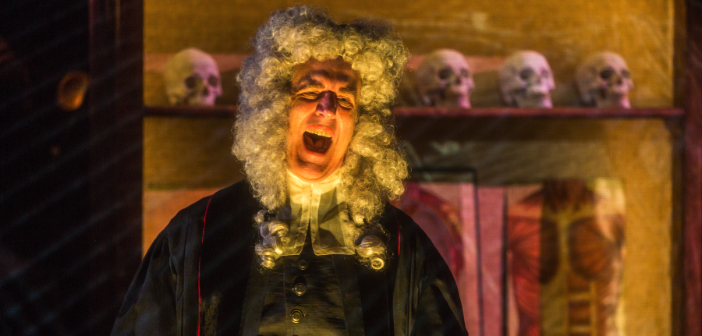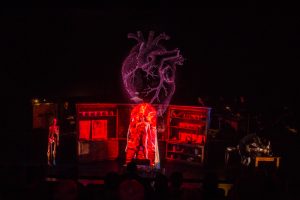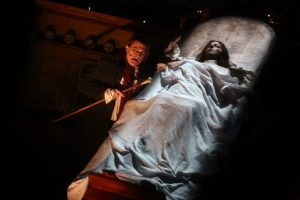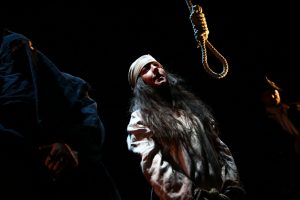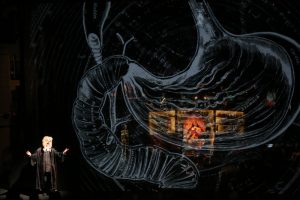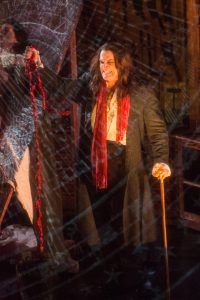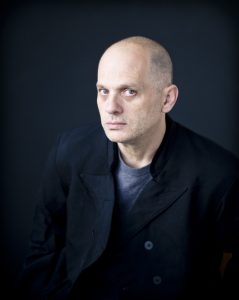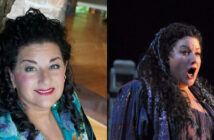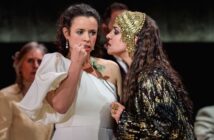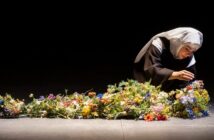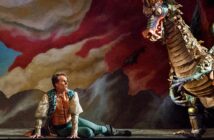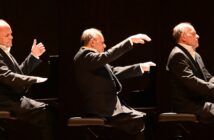OPERA REVIEW: anatomy theater, a new opera by David Lang and Mark Dion, part of the 2017 Prototype Festival, New York City (New York premiere, viewed January 7, 2017).
INTERVIEW: Composer David Lang.
She’s been hanged for murder – but men still can’t keep their hands off her.
Signs posted at the entrance to Brooklyn’s BRIC Arts | Media House for performances of anatomy theater warn of “simulated hanging” and “nudity” featured in the show. And, yep, both appraisals prove quite true (with nothing “simulated” about the latter, by the way). But no tipoff can adequately prepare one for the more existential disquietude meted out by the sly deviltry ahead.
The David Lang/Mark Dion opera, anatomy theater, begins with the execution of an 18th-century prostitute convicted of multiple homicides, but hardly ends there. The lady is still in for a few unkind cuts, as the opera’s principal action revolves around her body’s dissection at the hands of some gentlemen with some rather dicey agendas.
“People have always cut people open looking for things,” says composer Lang. “We imagine that people are cut open to heal them, or to learn how to heal people in the future. But of course people have been cutting people open forever, for all sorts of other reasons.”
And anatomy theater gets, quite literally, to the heart of some of those reasons, while also slicing away at layers of operatic propriety, and probing at questions of bodies and power, medicine and morality, the repression of women and the mystery of evil.
And, in its own uniquely macabre and rascally way, having a lot of fun doing it.
Quite a Body of Work
“I have always loved the work of the visual artist Mark Dion,” says Pulitzer-Prize-winning composer David Lang, “and so much of what I saw in his work I thought was theatrical.” It was thus that Lang contacted Dion and asked him if he’d be interested in a collaboration.
“We got together and we talked about one of the things he’s interested in,” says Lang. “The history of knowledge. The accumulation – and sometimes the mis-accumulation – of knowledge.” And out of that conversation came the idea of exploring how knowledge about something as intimate as the human body has been acquired – and exploited – by contending power structures.
The 18th Century seemed the right setting, the hinge between the modern and pre-modern worlds. But the period would only be a metaphor – our contemporary time and place would not be exempt from scrutiny.
“We didn’t want to have it too locked in the historical period,” says Lang. “I go to the theater and I only want to think about myself.”
To wit, Lang now waxes warm about a particular contemporary resonance he finds in the opera, albeit one he never intended at the time of composition.
“We just had a horrible election in which half of our population didn’t vote,” he says. “They were just bystanders.” And while “we didn’t make this piece with the events of our election in mind, it’s not a terrible thing occasionally to say that to watch something horrible is in a way to vote for something horrible.”
Not all anatomy theater audience members, of course, will share Lang’s specific opinion as to where modern horror lies. But it’s clear Lang hopes that, along with some good fiendish shivers, all will at least see some reflection of their own lives and times in his glass darkly.
For, you see, anatomy theater not only seduces us into watching; it makes us take responsibility for it.
Invitation to a Hanging
The anatomy theater experience begins before one enters the performance space proper. In a successful gambit of immersive theater, a large adjunct gallery space – its walls swathed in black – serves as an 18th-century “town square,” strewn with barrels and barrows, bales of hay and stands of merchants’ wares. Here, a bevy of wenches, sprung perhaps from Gay’s Beggar’s Opera, dispense savory sausages and tankards of ale and induct audience members into the carnival atmosphere of a scheduled public hanging, while assigning each visitor a membership in one of the privileged attending guilds – surgeons, physicians, barbers.
Suddenly, a drummer in tricorn hat appears, leading a procession. Two hooded figures (borrowed from some fever-dream auto-da-fé) escort the lovely, bedraggled, haunted-looking victim toward her fate. The audience follows into the theater and takes its seats. A heavy hangman’s noose dangles at the edge of the stage. The woman stands beside it, hands bound before her, staring stoically, silently at her assembled witnesses.
At length, the woman’s voice surges forth, and, in a tumult of rich emotion and gorgeously eloquent 18th-century diction, she both confesses and explicates her crime, narrating the sordid personal saga that has led her to the gallows: sexual abuse by a depraved stepfather, a descent into alcoholism, debasement at the hands of a cruel, pimping husband, and a final, desperate bid for escape in a spree of spectacular murder.
The language is remarkable, and the eloquence is of the essence here. The entire libretto of anatomy theater is putatively drawn largely from actual 17th– and 18th-century sources (legal documents, medical treatises), thus ensuring its Augustan sonority and marvelously persuasive redolence of place and period. Yet, via a thoroughgoing program of irony in the music, the staging, and the design, anatomy theater provokes and vexes with implications as unconstrained and corrosive as free radicals rampant in an organism’s depth structures. Cruelty, misogyny, intellectual imposture and flagrant ignorance may have wreaked havoc in the body politic of the 18th Century; could they not recrudesce with equal virulence today?
Slice of Life
The opera is populated by a quartet of richly defined characters; but none is so central as the woman hanged in its prologue – murderess Sarah Osborne. The rest of the evening not only revolves around her, it is quite literally extracted from her.
The flamboyant and seedy mountebank Joshua Crouch has obtained Osborne’s corpse, and now offers it up for spectacle. He has engaged the famed and aristocratic anatomist, Baron Peel, to conduct a demonstration autopsy – at least for those gentlemen among us willing to pay the fee (admittance to women is strictly barred!). The stated objective: to discern in which part of the woman’s body the physical sign of her wickedness lies (though the satisfactions of sheer transgressive voyeurism are winked at, as well).
Crouch becomes the evening’s subversive master of ceremonies; Peel, its rhapsodizing and polymath monomaniac of clinical misogyny. It falls, however, to the opera’s fourth character – the anatomist’s obliging young assistant, Ambrose Strang – to perform all the actual anatomical excisions from the woman’s remains, Peel having presumably risen above such menial, sullying piecework.
The opera’s main episodes, thus, are structured around the removal, one by one, of the woman’s vital organs – stomach, spleen, uterus – each held up to scrutiny, their terrifying and esoteric functions each musically eulogized, with texts of orotund alchemical and cosmological palaver from Baron Peel about humors and the elements and flesh and the devil.
Yet, to the anatomist’s chagrin, each organ fails to exhibit any pathology.
Crouch’s and Peel’s frustrations mount, while Strang, by contrast, seems gradually to start appreciating the elegance, beauty, even miraculous perfection of the female body he is dismantling – knowledge cutting both ways.
A final sortie yields the woman’s heart, and also inaugurates a stunning and sui generis denouement of lurid, palpitant, and deeply affecting theater, featuring (spoiler alert) an aria of melting poignancy and ravishing surprise performed by the woman’s corpse.
Bunch of Cut-Ups
anatomy theater is a wondrously unlikely amalgam – part Grand Guignol, part morality tale, part science lecture, part horror show. Ghoulish, gruesome, disquieting, and thoroughly engrossing, it might understandably prompt those of more delicate sensibility to leave early, but will defy any hardy enough to remain to look away.
The four principal performers, each with grounding in somewhat different musical genres and disciplines, all work marvelously together, and approach the thrills and challenges of anatomy theater with uncompromising conviction.
“I like to set up little problems for myself,” says Lang. “The problem in this piece was getting singers who are from different kinds of worlds, who have these different skills – how do you build a musical world where all of them feel equal and welcome and appropriate?”
Broadway baritone Marc Kudisch, as the evening’s sinister, sybaritic host, Joshua Crouch, proves to be oily perfection. His manner by turns leering, seductive, assaultive, crude, he might be the very Devil himself, wielding his ornate and arrantly phallic walking stick or lustfully caressing a demo skeleton in dissolute intimations of necrophilia. Kudisch’s voice is rich and flexible, yet capable of jarring deviations into insinuating nasality for moments of special, make-your-skin-crawl vocal effect.
Besides integrating performers of varying styles, Lang also bucks operatic orthodoxy by deploying discreet head mics for performances of anatomy theater. “Everything I listen to is amplified,” says Lang. “While it’s amazing to think that singers have the power to use their voices to fill a space acoustically, I feel like we respond to amplified music differently. And I like that sound.”
Legit operatic bass-baritone Robert Osborne (any relation to the opera’s central character?) plays the anatomist Peel with majestic authority and vigorous zeal. Bedecked in Isaac-Newton-like wig and voluminous academic robes, his physical and gestural life are dazzlingly convincing. Moreover, the clarity of Osborne’s diction is exemplary, and the potency of his chthonic voice can be felt in the listener’s own bones.
The role of the dutiful assistant, Strang, is portrayed with a beatific lambency by single-named tenor Timur (“who’s completely classically trained but also has a pop music background,” notes Lang). Timur’s voice has both light and warmth, and evinces admirable dynamic and coloristic range. And whether disemboweling a corpse or palpating body parts in his crimsoned hands, Timur brings poetry and humanity to the proceedings.
Perhaps the most heroic and uncompromising performance is that of mezzo-soprano Peabody Southwell, portraying convict and corpse. Southwell’s voice is rich, sensuous, kaleidoscopic. Her confessional prologue is a tour de force – an unparalleled fusing of vocal technique and hypnotic, hard-edged, raw emotion. Nor can one gainsay the bravery of her turn on the dissection slab. Southwell spends the better part of the evening lying fully inert and fully exposed, while her body is subjected to indignity and mutilation (one has to attend to see how that coup de theatre is pulled off).
Indeed, it was Southwell herself, says Lang, who insisted on the verisimilitude that gives such uncanny impact to the spectacle of the naked cadaver. “I would like to point out that that was her idea,” says Lang. “She said it makes absolutely no sense to do this any other way than naked.”
Quite so. “We’ve sort of forgotten that she’s a person,” Lang observes. “She’s there as a body on the slab and all these horrible things are being done to her. I sort of thought that that was a way we were complicit in her degradation.”
Music in Cut Time?
Lang has crafted a score chockful of ingenious effect and theatricality, all rendered with a deceptive economy of means.
“I played the trombone part in Threepenny Opera when I was in college,” says Lang, reflecting on the inspiration for his chamber scoring of anatomy theater which, indeed, doesn’t lack for a certain Brechtian touch. “There’s a nod to Kurt Weil and that kind of theater sound.”
But the comparison, apt as it may be on the surface, belies so much that is unique and remarkable in the score of anatomy theater. If one were to venture upon description, an overall (post)-minimalist, or even – (dare one say?) – neo-primitivist aesthetic governs (“I understand why all the labels exist,” interjects Lang. “It’s a shorthand; but I always bristled at it”); yet there is also fascinating variety within the tight and coherent sonic parameters Lang lays out for himself.
Some passages (such as the confessional prologue) evoke the naked immediacy of church plainchant (“I sang in a Gregorian chant choir at one point in my life,” says Lang, “and that music has had a very big effect on me”); other sequences conjure up boneyard-inflected strains of forlorn folksong.
But, by contrast, a wildly eccentric and extended trio vaunting the anatomist’s intention to display the instruments of his trade (“presently, I shall reveal”) reels out like a fevered scherzo variation on a Handelian canon – “The Trumpet Shall Sound” as scored for the inmates of Bedlam (indeed, the number even features a flashy solo line for the apposite brass player).
And yet another high-octane set-piece (“the instruments commonly required”) – cataloguing the anatomist’s grim panoply of knives, forceps, bellows and bone-saws – mounts with such terrifying intensity, so obsessively rhythmic, percussive and driven, it feels more harrowing than anything by Steve Reich or Philip Glass at their most daemonic.
“The way I tried to arrange the libretto,” says Lang, “was to have scenes begin with something that you feel is rational, and, as it goes farther, you realize, ‘oh, this is actually dangerous.’”
Musical Director Christopher Rountree, leading a nine-strong chamber klatch of accompanists drawn from the International Contemporary Ensemble, keeps all the complex rhythms and vibrant melodies whirring in keen operation, sharp as a scalpel and tight as a suture.
Director Bob McGrath exhibits unflagging inventiveness in shaping the action over and around the many eye-catching, gothic elements of the set (designed, of course, by collaborator Mark Dion).
Video and projection designers Bill Morrison and Laurie Olinder, respectively, contribute indispensable visual support to the multi-layered implications of the show, while sound design by Garth MacAleavey provides crucial and transparent support, and costumes by Alixandra Gage Englund are rich in character detail and period feel.
All that Remains
The themes and sensibility of anatomy theater might well owe something to a reading of social historians such as Michel Foucault, whose seminal Birth of the Clinic (1963), The Order of Things (1966), and Discipline and Punish (1975) did much to excavate and distill the psychosocial latencies of Western medical, scientific, and penal practices through the ages. It’s patently not for the squeamish or faint of heart, but the ideas in anatomy theater are important, and its targets are rich.
“Trying to figure out how to protect ourselves from evil,” says Lang, “these are unfortunately issues which never go away.” Yet the opera is written and performed with such affirmative energy, verve, ingenuity and lightness of touch that it transcends any portentousness that might otherwise have hobbled it. There is also much humor here, even if much of it is of an intentionally squirm-inducing variety – delayed guffaws here; sudden, goosed shrieks of micro-scandal there. In short, anatomy theater is that rare kind of theatrical one-off, successfully admixing equal parts intellectual ambition and in-your-face gross-out. It’s sure to pierce through to the darker folds of your cerebral cortex.
All it needs is its 90-minute playing time to get under your skin.
________________________________________
anatomy theater is produced by Beth Morrison Projects, along with HERE, as part of the 2017 Prototype Festival of new works, with performances on January 7, 8 10, 11, 12, 13 and 14, 2017 at Brooklyn’s BRIC Arts | Media House, 647 Fulton Street. The entire Prototype Festival this year runs from January 5 through the 15th, with other productions at various venues around the city, ranging from the New York premiere of Missy Mazzoli’s and Royce Vavrek’s musically dense and morally disturbing Breaking the Waves (the Opera Philadelphia world premiere of which was reviewed here on September 29, 2016) to a workshop reading of REV. 23 – a mischievous riff on St. John’s Apocalypse with a score by Julian Wachner and an original concept and libretto by Cerise Lim Jacobs (whose grand and extravagant Ouroboros Trilogy was reviewed here on September 14, 2016). Full programming and scheduling information for the 2017 Prototype Festival may be accessed here.

